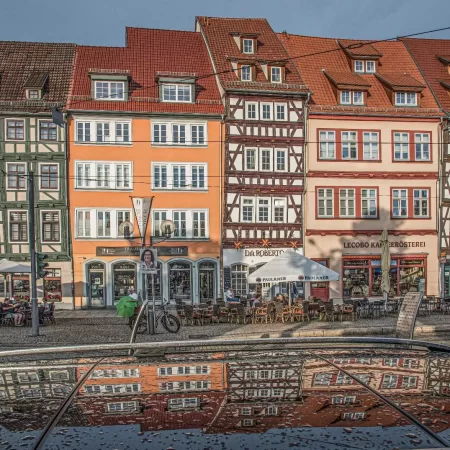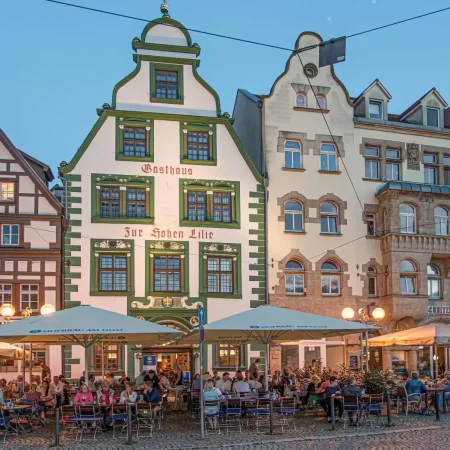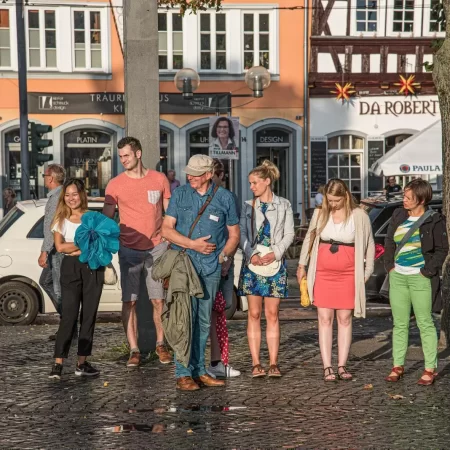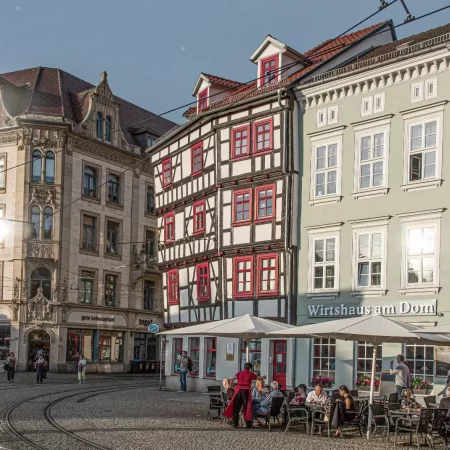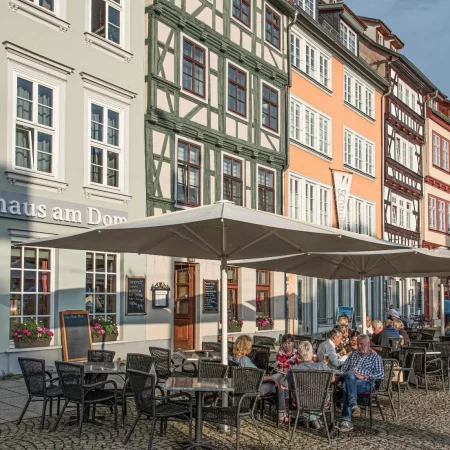The famous Erfurt Cathedral Square is characterised by the visually striking interplay between Erfurt Cathedral and St. Severi Church. The square also features the Minerva Fountain, which dates back to 1784. Another sight worth seeing is the Erthal Obelisk, erected in 1777 in honour of the Elector of Mainz. A total of 70 steps lead up the hill to Cathedral Square. They have only existed in their current form since the mid-19th century. The district that originally belonged to Severi Church was destroyed by French artillery fire in 1813 and was not rebuilt afterwards. As a result, Cathedral Square is now considerably larger. The Petersberg Citadel rises to the north-west of Cathedral Square.
Sights: St. Mary’s Cathedral & St. Severi Church
Two churches as landmarks of the city
If you are in Erfurt, you must visit Erfurt Cathedral Square. It is the city’s central square – huge, open and steeped in history. Here you will find two impressive buildings: Cathedral Church of St. Mary and St. Severi Church. The two churches tower majestically over the cathedral square. They stand right next to each other and form a unique architectural masterpiece.
St. Mary’s Cathedral is particularly famous for its bell ‘Gloriosa’, which is over 500 years old. It is the largest free-swinging medieval bell in the world and was cast in 1497. With a height of 2.50 m and a diameter of 2.57 m, it weighs 11,450 kg. If you’re lucky, you might even hear it ringing. Right next to it stands St. Severi Church, which stands out with its five towers. It is one of the few five-nave Gothic hall churches in Germany. Together, the two churches form the famous postcard motif of Erfurt – the sight is simply magnificent!
View and atmosphere on Cathedral Square
From Domplatz square, you can climb a 70-step staircase to Domberg hill. From here, you have an impressive view of the entire Domplatz square. It is not only the churches that make it special. It is lined with well-restored historic buildings. There are some great photo opportunities here. On Domplatz square in Erfurt, you will find many statues, fountains and small details. Some of them are easy to overlook – so keep your eyes open! The Marian Column in the middle of the square, for example, is a real eye-catcher.
History: Significant events at Erfurt Cathedral Square
Medieval trading centre and religious hub
Erfurt’s cathedral square has a long and exciting history. The square was already a central location in the Middle Ages. At that time, important trade routes converged here, and all kinds of goods were traded: salt, fabrics, grain. It was the heart of the city – and has remained so to this day. St. Mary’s Cathedral dates back to the 12th century, but there was a church here even before that. The cathedral was also the place where Martin Luther was ordained as a priest. His time in Erfurt had a major influence on his later work.
St. Severi Church was also built in the Middle Ages, around the 13th century. Both churches have been repeatedly rebuilt, expanded and restored over the centuries. The buildings tell of the city’s power, faith and wealth. During the Reformation and also during the Thirty Years’ War, the cathedral square was often the scene of political and religious conflicts.
Destruction, reconstruction and living memory
Erfurt’s cathedral square was also hit during the Second World War. Fortunately, St. Mary’s Cathedral and St. Severi Church remained relatively undamaged. After the war, the square was redesigned. Today, it connects the past and present in a unique way.
You can still feel the history here – when walking over the cobblestones, looking at the old walls or simply sitting in one of the cafés and taking it all in. Erfurt’s cathedral square is not only a beautiful place, but also a piece of living history.
Surroundings: Discover the city from Erfurt’s cathedral square
Sights in the immediate vicinity
Erfurt Cathedral Square is located right in the heart of the city. From here, you can explore the entire old town of Erfurt at your leisure. In just a few minutes, you can reach Krämerbrücke, which we highly recommend. It is the longest built-up bridge in Europe. In 32 houses, you will find numerous shops, antiques and handicrafts – definitely a special highlight of Erfurt.
The Erfurt fish market is also within easy walking distance. Here you can see the neo-Gothic town hall, built in 1875, and numerous impressive town houses. The buildings, dating from the 15th or 16th century, are elaborately decorated and impress with their magnificent Renaissance façades.
View, cafés and special atmosphere
The Petersberg Citadel is just around the corner. It’s only a few minutes’ walk away. It is one of the largest Baroque city fortresses in Central Europe and has been largely preserved. From here, you have a great view of the city. Johann Wolfgang von Goethe (1749–1832) was already impressed by the citadel’s fortress architecture. He described it several times in his diaries and letters.
Wenn du gern Kaffee trinkst oder einfach nur chillen willst: Rund um den Domplatz Erfurt gibt’s viele Cafés, kleine Läden und Restaurants. Die Mischung aus Tradition und Moderne ist echt charmant. Kurz gesagt: Der Domplatz Erfurt ist nicht nur für sich genommen beeindruckend – auch seine Umgebung macht ihn so besonders. Ob Sightseeing, Shoppen oder Entspannen: Von hier aus hast du den idealen Ausgangspunkt.

